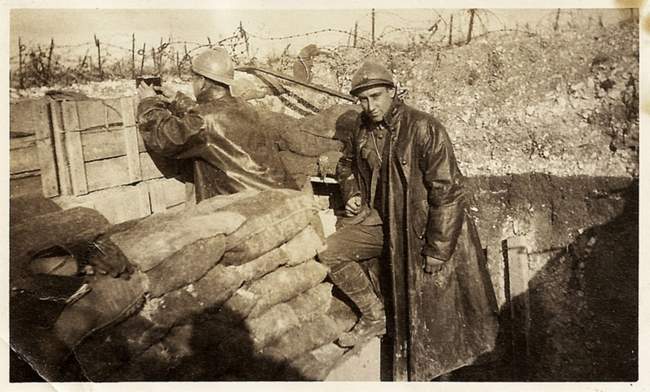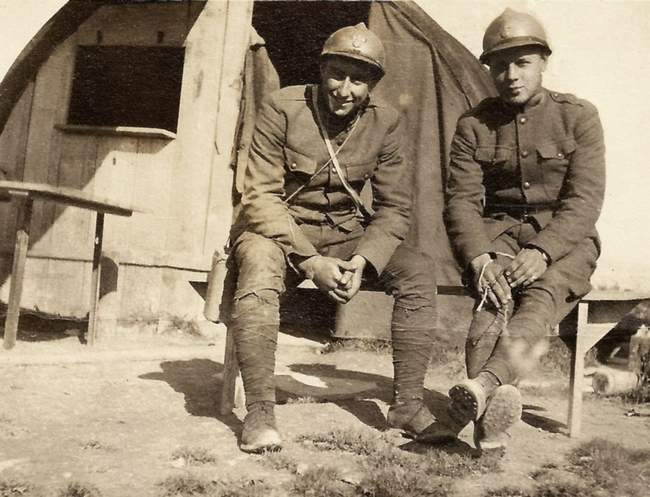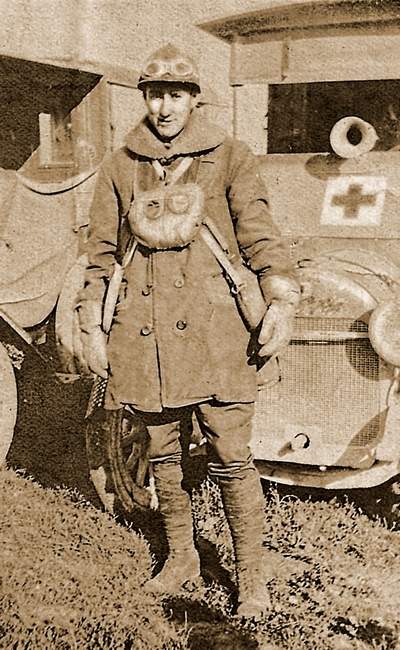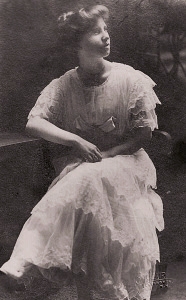History Matters
By Cheryl Lassiter
Hampton Union, November 10, 2015
[The following article is courtesy of the Hampton Union and Seacoast Online.]

“70 yards from the German trenches.” Rupert Lindsey in the French trenches, Champagne-Ardennes, October 1917
A volunteer ambulance driver in World War I was not selected for his ability to bind a wound or repair his temperamental transport vehicle. As one recruiter put it, “a volunteer must be a man of good disposition possessed of self-control – in short, a gentleman.” Fitting the bill was handsome, outgoing, 19-year-old Clark College student Rupert “Rupe” Wilder Lindsey, who is believed to have been the first Hampton man to leave for duty in World War I Europe.
The war-time ambulance services recruited heavily on college campuses, and many of the elite schools formed volunteer units. In May 1917, “to show his patriotism for his country and his flag,” Rupert joined the Clark College Ambulance Unit and was accepted as a driver for the Paris-based American Field Service (AFS). On June 9, 1917 he sailed from New York to Bordeaux, France aboard the transport ship Espagne.
At the time, some 75 college students per week were signing up at the AFS recruiting office in Boston, far more than could be employed as ambulance drivers. Rather than turn them away and dampen the fervor, the AFS played a bait-and-switch game. Not until the day of departure were the recruits told that they would be stuck driving camions (transport trucks) instead of heroically saving lives as “ambulanciers.” This did not suit a number of these young gentlemen volunteers, Rupert included, who had joined as much for an exciting adventure as for altruism.

“Two fools laughing at a camera on a box.” Rupert Lindsey and co-driver Mac, Champagne-Ardennes, October 1917.
When Rupert arrived in Paris he obtained a release from the AFS and joined the American Ambulance Service, a private hospital run by Americans in the Paris suburb of Neuilly. There, with his co-driver Mac, he performed “jitney duty”—transporting wounded soldiers to the hospital from the trains rolling in from the front lines. He was soon stationed near the front with the French 26th Division, transporting the wounded to “postes de secour” (field hospitals).

Rupert Lindsey with gas mask, near Verdun, France, August 1917
Camp at Triancourt, France
September 1, 1917
Dear Ernestine —
The last time I wrote I was leaving for the Front, wasn’t I? Well, I went and saw and did and here I am still in range of cannon. The French infantry took le Mort Homme and Hill 304, and it was interesting to see the French artillery moved up and the wonderful rapidity of the advance all along. But the other side of it, the wounded and dead during the attack. Men often died before we could reach the hospital, the car covered with blood and all. That’s what tries a fellow’s nerve if anything.
But for a while that is all over for us. We are on repos in Triancourt; the best part of it is that you can get something to eat, omelette, wine, toasted bread, butter, and all the jam you can eat. That is what we all like to get back for after living on sardines and boiled beef.
For this time c’est assez, but I hope to hear from you soon. Perhaps then I shall not be a Volunteer Ambulancier, but with the U.S. Army.
Most sincerely, Rupe
The ambulance corps were absorbed by the Red Cross and the United States Army. After a short leave home, in January 1918 Rupert went to Italy to drive ambulances for the U.S. Army. While he felt that he had been overlooked for a Croix de Guerre in France, he was awarded the War Cross for valor in Italy. In September the War Department assigned Rupert “for duty with the American Expeditionary Force in connection with the Red Cross.” He was assigned to Section IV, Ernest Hemingway’s unit in northern Italy. Unlike the writer, he was never injured, and was driving at the Battle of Vittorio Veneto (October 24-November 3, 1918), which marked the defeat of the Austro-Hungarian Empire. The following letter was written in the battle’s aftermath.
Italian Front
November 7, 1918
Dear Ernestine—
I was sent down on the Piave River on the 23rd of October and the same night was sent out to a poste on the river called Cavallea where everything was ready for the offensive.
The bombardment came on the night of the 25th and under the artillery fire the Italians put up two bridges. Two brigades got across before the bridges were blown up by the Austrians and all that day there was lively fighting. For a while things looked very doubtful.
I was sent from my poste to a town four kilometers up the river where there were eight soldiers severely wounded. The road was lined with trenches full of soldiers ready to cross, shells were flying everywhere, searchlights were all over the place where the wounded were. Luckily I got the first load back to the hospital before I fell into one monstrous large shell hole. By the time I arrived for the second load, it was getting daylight and I could see the bridge and the French and Italians hurrying across. The Austrians were shelling heavily and many of the soldiers never made it. I saw one man thrown into the air in two parts and one part of him stuck in the remains of a tree. For once I never expected to return from that trip and to this minute I don’t understand how I got back without even as much as a scratch.
Remember I said some months ago that the war might be over by Christmas? What do you think of it now? There is only Germany left and she can’t stand it long.
As ever most sincerely,
Rupe
Four days later, at the 11th hour of the 11th day of the 11th month, the Allies and Germany signed the Armistice of Compiegne to end the war.

Rupert Lindsey service portrait, 1918
Early life
Rupert was born in Manchester, New Hampshire in 1897. He moved to Hampton as an infant with his father, barber George Lindsey, and his mother Alice Godfrey, daughter of Hampton Civil War veteran Jacob Godfrey. Rupert grew up to be a bright young man, a cornet player, active in various clubs and the school baseball team. Ernestine, the spunky, blue-eyed, red-haired daughter of Hampton businessman Ernest G. Cole, was his childhood sweetheart. After graduating from Hampton Academy in 1915 Rupert entered Clark College in Worcester. Ernestine enrolled at Holyoke College in South Hadley, Massachusetts, working at her father’s Hampton Beach post office in the summer.
After the war
 Rupert’s war experiences are known to us mainly from 18 letters he wrote to Ernestine in Hampton and South Hadley. In 2009 the Hampton Historical Society received the letters as part of a larger donation of Cole and Page family papers, donated by Ernestine’s daughter Carole Wygant Felter.
Rupert’s war experiences are known to us mainly from 18 letters he wrote to Ernestine in Hampton and South Hadley. In 2009 the Hampton Historical Society received the letters as part of a larger donation of Cole and Page family papers, donated by Ernestine’s daughter Carole Wygant Felter.
Carole says that Rupert wanted to marry her mother but the feeling wasn’t mutual. On the day that Rupert came to her house to propose, Ernestine surrounded herself with girlfriends to thwart the attempt. He never spoke to her again.
In June 1919 Rupert graduated from Clark College with a degree in English. On November 11, 1919, he participated in the first Armistice Day commemoration in Hampton. He later moved to Chicago and found work as a salesman for a plastics materials manufacturer, married Marguerite Frisz of Indiana, and had two children, Lawrence (born 1928) and Robert (born 1930). By 1945 Rupert and his family were living in Clearwater, Florida. He passed away at the age of 92 in St. Petersburg on Christmas Eve 1989.
Ernestine (photo at left, ca. 1920) became a teacher, married Calvin Wygant of New York State, and raised a family of her own. She passed away in 2001 at 103 years old. Thanks to her life-long regard for her childhood friend, Rupert’s letters and photographs from the battlefields of WWI France and Italy have been preserved.
History Matters is a monthly column devoted to the history of Hampton and Hampton Beach. Cheryl Lassiter is the author of “The Mark of Goody Cole: a tragic and true tale of witchcraft persecution from the history of early America” (2014). Her website is www.lassitergang.com.
History Matters column leads to special gift
By Kathryn McLaughlin
Hampton Union, February 19, 2016
[The following article is courtesy of the Hampton Union and Seacoast Online.]
Shawn Lindsey, Gerry Lindsey and Cheryl Lassiter at The Tuck Museum.
HAMPTON — It was a posting on the Hampton Historical Society (HHS) Facebook page that led Rupert Lindsey’s family to donate a collection of his belongings to the Tuck Museum. The post – Cheryl Lassiter’s November 2015 “History Matters” column from the Hampton Union entitled “A Gentleman Volunteer.”
The gentleman volunteer – Rupert Lindsey, who, at 19 years old, is believed to be the first Hampton man to serve in World War I in Europe. Rupert served first as a volunteer ambulance driver, then as an American soldier.
Rupert’s grandson, living in Medway, Mass., had “liked” the HHS Facebook page when he was doing genealogy research, so was notified when the column was posted. “I opened the link and saw my grandfather looking back at me!” said Gerry Lindsey.
Coincidentally, the family was cataloguing personal papers and other items Rupert had left to Gerry’s father when he died.
“There was a box of mementos, unopened from Rupe’s death in 1989 until just a few years ago,” said Gerry. “It contained his World War I photo albums and miscellaneous personal memorabilia. Rupe’s uncle owned a photography studio in Manchester and gave him a camera to take with him.
“My son, Shawn, and my sister, Joan, were interested in telling Rupe’s war story, and we took the items out to begin to catalog them and make sense of the stories we were told as children,” Gerry said. Shawn is completing a novel based on Rupert’s life leading up to the war and his return home.
The family had discussed different organizations where Rupert’s material might reside. It was when they read Cheryl’s column, and learned about Rupert’s war experiences through letters home to Hampton they knew nothing about, that they decided on HHS.
“The letters, which detailed so much of his adventures, are the perfect companion for the pictures we have and his war diaries,” said Gerry. “So the decision to begin the process of donating his memorabilia to HHS was an easy one. Rupe was a son of Hampton and we pulled together items to donate.”
The initial donation includes:
– An essay Rupert wrote as he was graduating from grammar school.
– The musical score to “A Merry Company,” a comic operetta performed at Hampton Academy.
– Rupert’s 1915 Hampton Academy graduation program.
– Scans of Rupert’s war diaries.
– Minutes for a 1919 Baptist Brotherhood meeting in Hampton where Rupert spoke about the war.
– Photographs of Rupert later in life.
– Gerry’s written recollections of his grandfather.
Betty Moore, Tuck Museum director, and Cheryl, met Gerry and Shawn when they brought the donation to the museum in December 2015.
“We knew a part of Rupert’s life as a boy and young man that his family knew nothing about, and they knew about Rupert’s life as an adult once he left Hampton that we knew very little about,” said Betty. “We learned that Gerry was very close to his grandfather, spending a lot of time with him as a young boy through his adult years. And that Rupert was a very successful businessman, inventing plastic for handles on pots, pans and knives.
“The letters Rupert wrote during the war were to a childhood friend, Ernestine Cole,” Betty continued. “We think he hoped to marry her but she did not have similar feelings.”
“We didn’t know about Ernestine and the letters were quite an eye opener,” said Gerry. “Rupe met and married my grandmother in the 1920’s in Chicago, and was married over 65 years!”
HHS thanks the Lindsey family for their donation to the Tuck Museum.
